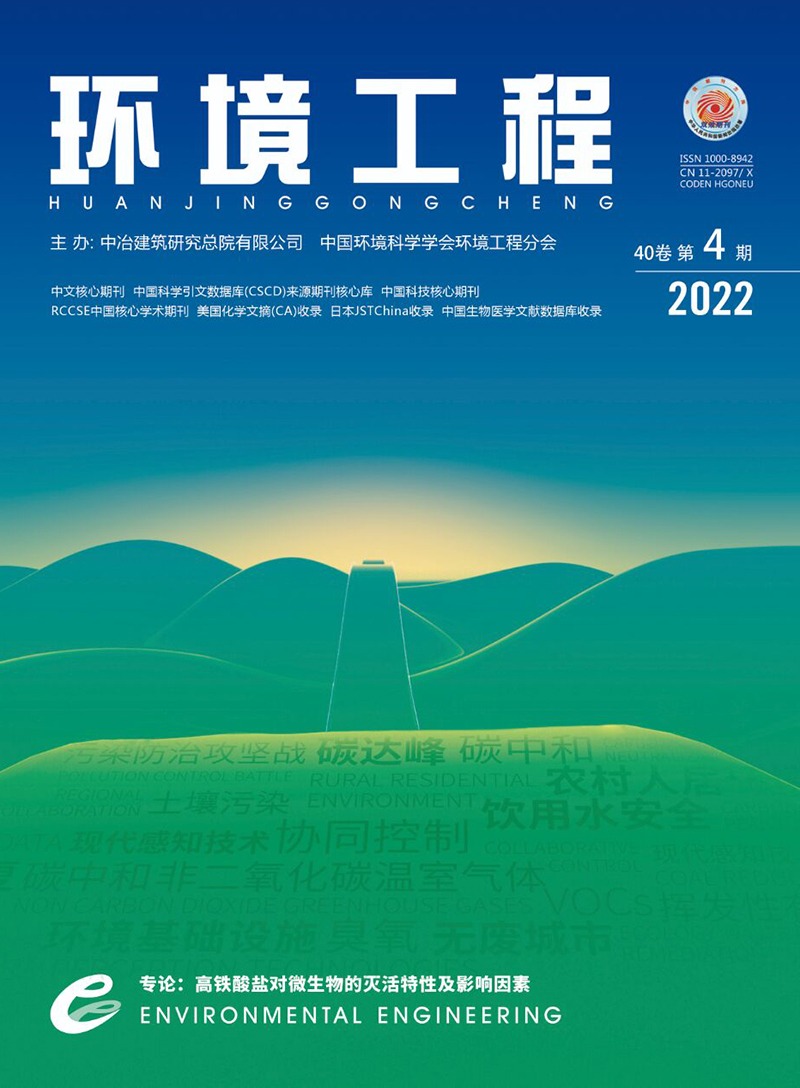| [1] |
GIROTTO F, ALIBARDI L, COSSU R. Food waste generation and industrial uses:a review[J]. Waste Management, 2015, 45:32-41.
|
| [2] |
KIBLER K M, REINHART D, HAWKINS C, et al. Food waste and the food-energy-water nexus:a review of food waste management alternatives[J]. Waste Management, 2018, 74:52-62.
|
| [3] |
AWASTHI S K, SARSAIYA S, AWASTHI M K, et al. Changes in global trends in food waste composting:research challenges and opportunities[J]. Bioresource Technology, 2020, 299:122555.
|
| [4] |
BEDOICĆ R, ŠPEHAR A, PULJKO J, et al. Opportunities and challenges:experimental and kinetic analysis of anaerobic co-digestion of food waste and rendering industry streams for biogas production[J]. Renewable and Sustainable Energy Reviews, 2020, 130:109951.
|
| [5] |
MORONE P, KOUTINAS A, GATHERGOOD N, et al. Food waste:challenges and opportunities for enhancing the emerging bio-economy[J]. Journal of Cleaner Production, 2019, 221:10-16.
|
| [6] |
VELIS C A, LONGHURST P J, DREW G H, et al. Bio-drying for mechanical-biological treatment of wastes:a review of process science and engineering[J]. Bioresource Technology, 2009, 100(11):2747-2761.
|
| [7] |
TAMBONE F, SCAGLIA B, SCOTTI S, et al. Effects of bio-drying process on municipal solid waste properties[J]. Bioresource Technology, 2011, 102(16):7443-7450.
|
| [8] |
TOM A P, PAWELS R, HARIDAS A. Bio-drying process:a sustainable technology for treatment of municipal solid waste with high moisture content[J]. Waste Management, 2016, 49:64-72.
|
| [9] |
WAGLAND S T, GODLEY A R, TYRREL S F. Investigation of the application of an enzyme-based biodegradability test method to a municipal solid waste bio-drying process[J]. Waste Management, 2011, 31(7):1467-1471.
|
| [10] |
YUAN J, ZHANG D F, MA R N, et al. Effects of inoculation amount and application method on the bio-drying performance of municipal solid waste and the odor emissions produced[J]. Waste Management, 2019, 93:91-99.
|
| [11] |
HUILINIR C, VILLEGAS M. Bio-drying of pulp and paper secondary sludge:kinetics of volatile solids biodegradation[J]. Bioresource Technology, 2014, 157:206-213.
|
| [12] |
LIU T T, CUI C W, HE J G, et al. Insights into the succession of the bacterial microbiota during bio-drying of storage sludge mixed with beer lees:studies on its biodiversity, structure, associations, and functionality[J]. Science of the Total Environnebt, 2018, 644:1088-1100.
|
| [13] |
LIU T T, HE J G, CUI C W, et al. Exploiting community structure, interactions and functional characteristics of fungi involved in the bio-drying of storage sludge and beer lees[J]. Journal of Environmental Management, 2019, 232:321-329.
|
| [14] |
NAVAEE-ARDEH S, BERTRAND F, STUART P R. Key variables analysis of a novel continuous bio-drying process for drying mixed sludge[J]. Bioresource Technology, 2010, 101(10):3379-3387.
|
| [15] |
VILLEGAS M, HUILINIR C. Bio-drying of sewage sludge:kinetics of volatile solids degradation under different initial moisture contents and air-flow rates[J]. Bioresource Technology, 2014, 174:33-41.
|
| [16] |
黄文雄,苏红玉,黄丹丹,等.通风方式对高含水率垃圾生物干化的影响[J].中国环境科学, 2012, 32(8):1480-1486.
|
| [17] |
詹亚斌,魏雨泉,林永锋,等.通风模式对餐厨垃圾生物干化能效及氮素损失的影响[J].环境工程, 2021,39(5):124-130.
|
| [18] |
YUAN J, ZHANG D F, LI Y, et al. Effects of the aeration pattern, aeration rate, and turning frequency on municipal solid waste bio-drying performance[J]. Journal of Environmental Management, 2018, 218:416-424.
|
| [19] |
ZHANG S C, WANG J L, CHEN X, et al. Industrial-scale food waste composting:effects of aeration frequencies on oxygen consumption, enzymatic activities and bacterial community succession[J]. Bioresource Technology, 2021, 320(Pt A):124357.
|
| [20] |
MA J, ZHANG L, LI A M. Energy-efficient co-bio-drying of dewatered sludge and food waste:synergistic enhancement and variables investigation[J]. Waste Management, 2016, 56:411-422.
|
| [21] |
张小娟,黄绍松,孙水裕,等.接种菌剂对城市污泥生物干化过程中干化效果和氮素转化的影响[J].环境工程学报, 2014, 8(4):1669-1673.
|
| [22] |
张智烨,袁京,王国英,等.辅料添加对厨余垃圾生物干化产品燃烧热特性的影响[J].环境工程学报, 2020, 14(5):1365-1375.
|
| [23] |
袁京,张地方,李赟,等.外加碳源对厨余垃圾生物干化效果的影响[J].中国环境科学, 2017, 37(2):628-635.
|
| [24] |
MA J, ZHANG L, MU L, et al. Multivariate insights of bulking agents influence on co-bio-drying of sewage sludge and food waste:process performance, organics degradation and microbial community[J]. Science of the Total Environment, 2019, 681:18-27.
|
| [25] |
马海霞,张丽丽,孙晓萌,等.基于宏组学方法认识微生物群落及其功能[J].微生物学通报, 2015, 42(5):902-912.
|
| [26] |
ALBERTSEN M, HUGENHOLTZ P, SKARSHEWSKI A, et al. Genome sequences of rare, uncultured bacteria obtained by differential coverage binning of multiple metagenomes[J]. Nature Biotechnology, 2013, 31(6):533-538.
|
| [27] |
CAO M K, GUO H T, ZHENG G D, et al. Microbial succession and degradation during kitchen waste bio-drying, highlighting the thermophilic phase[J]. Bioresource Technology, 2021, 326:1247-1262.
|
| [28] |
LI Y Z, CHEN Z, PENG Y Y, et al. Changes in aerobic fermentation and microbial community structure in food waste derived from different dietary regimes[J]. Bioresource Technology, 2020, 317:123948.
|
| [29] |
QIN R H, SU C Y, MO T H, et al. Effect of excess sludge and food waste feeding ratio on the nutrient fractions, and bacterial and fungal community during aerobic co-composting[J]. Bioresource Technology, 2021, 320(Pt A):124339.
|
| [30] |
WANG X J, PAN S Q, ZHANG Z J, et al. Effects of the feeding ratio of food waste on fed-batch aerobic composting and its microbial community[J]. Bioresource Technology, 2017, 224:397-404.
|
| [31] |
蔡璐,葛奇峰,高定,等.城市污泥生物干化过程的有机质转化与产水规律[J].农业工程学报, 2016, 32(5):274-279.
|
| [32] |
ZHANG L L, JIA Y Y, ZHANG X M, et al. Wheat straw:an inefficient substrate for rapid natural lignocellulosic composting[J]. Bioresource Technology, 2016, 209:402-406.
|
| [33] |
向虹霖,蒋建国,高语晨,等.通风量对有机废弃物生物干化的影响[J].环境工程, 2020, 38(2):128-134.
|
| [34] |
王秀红,李欣欣,史向远,等.好氧堆肥微生物代谢多样性及其细菌群落结构[J].环境科学研究, 2018, 31(8):1457-1463.
|
| [35] |
ZHANG L L, ZHANG H Q, WANG Z H, et al. Dynamic changes of the dominant functioning microbial community in the compost of a 90-m (3) aerobic solid state fermentor revealed by integrated meta-omics[J]. Bioresource Technology, 2016, 203:1-10.
|
| [36] |
TAKEBAYASHI S, NARIHIRO T, FUJII Y, et al. Water availability is a critical determinant of a population shift from Proteobacteria to Actinobacteria during start-up operation of mesophilic fed-batch composting[J]. Microbes and Environments, 2007, 22(3):279-289.
|


 Login
Login Register
Register E-alert
E-alert






 DownLoad:
DownLoad: